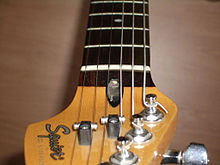Truss rod
The truss rod , also Halseinstellstab , neck tension rod , tie rod and recliner called (English truss rod ), is an adjustable rod made of steel , which internally in the neck of some musical instruments from the family of sounds is installed. When tensioned, the rod counteracts the tensile force of the strings and thus compensates for the resulting curvature of the instrument neck. Since gut and nylon strings only exert a low tensile force on the neck, neck tension rods are mainly used for plucked instrumentsused with steel strings. Particularly Western guitars , archtop guitars, solid body - electric guitars and basses have a neck tie rod in most cases.
history
Already at the beginning of the 18th century , guitar makers were looking for a reinforcement of the neck in various ways in order to counteract the sometimes enormous tension on the neck. The first truss rods consisted only of a strip of ebony , which was completely sufficient for the conditions at the time, since the gut strings used did not have a particularly high tension. At the beginning of the 19th century , American guitar manufacturers began to produce steel-string guitars whose tension was much higher than that of gut strings, which meant that the ebony strip used until then was often no longer sufficient to reinforce the neck. So the designers began to enlarge the cross-section of the neck, which in turn affected the playability, as these necks could hardly be grasped.
In the early 1920s, Lloyd Loar , then head of the development department at the American musical instrument manufacturer Gibson Guitar Corporation , invented the adjustable steel rod, which made it possible to make the necks slimmer again. Until the early 1950s, due to patent law, only Gibson guitars were allowed to have such a stick. After the patent expired, all guitar manufacturers switched to the adjustable steel rod - except for Martin Guitars , who did not use an adjustable steel rod until 1985.
construction

The truss rod lies in a longitudinal channel inside the neck. The milling and insertion of the rod is done either from the fingerboard side, before the fingerboard is glued to the neck, or from the back of the neck. In the latter case, if the neck is not completely coated, the filling of the milling channel can be seen from the outside. Sometimes a different colored wood is used for this (so-called Skunk Stripe ). When viewed from the fingerboard, the channel for the staff describes a slightly convex arc. In the middle of the neck, the stick inside is furthest away from the fingerboard. At the ends it is screwed against the wood of the neck so that it can be put under tension. Depending on the guitar model, this tension is set either at the head end (usually hidden under a decorative and screwed-on plate) or at the end of the neck connected to the instrument body. With the latter design in particular, the truss rod can only be adjusted after the neck has been unscrewed on some types of instruments with a screw neck. There are various solutions to this problem - mostly with the aim of hiding the tie rod from the outside as much as possible, but still making it easy to adjust.
Mode of action
If the truss rod is put under tension, the curvature of the rod causes the fingerboard to be pushed up in the middle and the neck to bend backwards when viewed from the player. The tension of the strings counteracts this tendency. If the neck is optimally adjusted, it will even bend slightly forward, as the string oscillation in the middle of the string length has the greatest amplitude when playing the instrument . If the tension of the rod is too great, the neck is straight or bends backwards. When struck, the strings quickly touch the fingerboard (with a fretless neck) or the frets and rattle. If the tension of the tension rod is set too weak, the neck will bend too far forward. Then the problem arises that the playability of the instrument is worsened by the high string position (distance between the strings and the fingerboard). Precise playing and good intonation are more difficult to achieve. To adjust the tensioning rod (on the bullet ) with an Allen key or a screwdriver, it is recommended to tune the strings beforehand. The adjustment rod is ideally adjusted when the neck is slightly hollow, so that when the strings are placed on the frets at the first and last fret presses, there is about 0.8 mm of space between the string and the fourth fret.
As a rule, new instruments should be shipped from the factory with the truss rod properly adjusted. An adjustment of the rod can be appropriate, for example, when strings of a different thickness are pulled.
literature
- Teja Gerken, Michael Simmons, Frank Ford, Richard Johnston: Acoustic guitars: Everything about construction and history , Munich 2003, ISBN 3-910098-24-X
Individual evidence
- ↑ Teja Gerken, Michael Simmons, Frank Ford, Richard Johnston: Acoustic guitars: Everything about construction and history. Munich 2003, p. 81 f.
- ^ Tony Bacon, Paul Day: The Ultimate Guitar Book. Edited by Nigel Osborne, Dorling Kindersley, London / New York / Stuttgart 1991; Reprint 1993, ISBN 0-86318-640-8 , p. 188.
Web links
- Youtube: The truss rod - what is it? (accessed on January 18, 2018).
- Instructions for correctly setting the neck tensioning rod at justchords.de (accessed on March 2, 2011).
- Information on guitar making : Adjust the truss rod correctly (accessed January 18, 2018).
